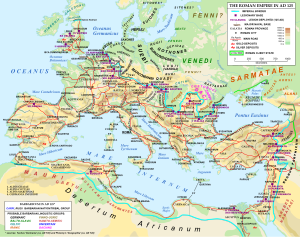Legio IX Hispana
| Legio IX Hispana | |
|---|---|
 Map of the Roman empire in AD 125, under emperor Hadrian, showing the Legio IX Hispana, then stationed (from AD 121 to ca. 132) on the river Rhine at Noviomagus (Nijmegen, Netherlands), in Germania Inferior province | |
| Active | Before 58 BC to sometime in the 2nd century |
| Country | Roman Republic and Roman Empire |
| Type | Roman legion (Marian) |
| Role | Infantry assault |
| Garrison/HQ | Eboracum (71 - ?) |
| Mascot(s) | Bull (likely) |
| Engagements | Gallic Wars (58-51 BC) Cantabrian Wars (29-19 BC) |
| Commanders | |
| Notable commanders | Julius Caesar |
Legio nona Hispana (Ninth Hispanic Legion)[1] was a Roman legion. While the legion's standard is unknown, it was likely a bull, which was used by other legions created by Julius Caesar. It was raised, along with the 6th, 7th and 8th, by Pompey in Spain in 65 BC [2]. Caesar first commanded them as Governor of Further Spain in 61 BC. He brought them over to Gaul around 58 BC, where they were present during the whole campaign of the Gallic wars.
The 9th was withdrawn to Spain in 49 BC where it earned the title “Hispaniensis”. (Caesar’s Gallic Wars) Later, they remained faithful to Caesar in the civil war. They fought in the battles of Dyrrhachium and Pharsalus (48 BC) and in the African campaign of 46 BC. After his final victory, Caesar disbanded the legion and settled the veterans in the area of Picenum.
Following Caesar's assassination, Octavian recalled the veterans of the Ninth to fight against the rebellion of Sextus Pompeius in Sicily. After defeating Sextus, they were sent to the province of Macedonia. The Ninth remained with Octavian in his war of 31 BC against Mark Antony and fought by his side in the battle of Actium. With Octavian as sole ruler of the Roman world, the legion was sent to Hispania to take part in the large scale campaign against the Cantabrians (25–13 BC). Their surname Hispana likely dates from this event and was probably earned for distinction in fighting.
After this, the legion was probably a member of the imperial army in the Rhine border that was campaigning against the Germanic tribes. Following the abandonment of the Eastern Rhine area (after the disaster of the Battle of the Teutoburg Forest — AD 9), the Ninth was relocated in Pannonia.
Invasion of Britain
In 43 they participated in the Roman invasion of Britain led by emperor Claudius and general Aulus Plautius. Under the command of Caesius Nasica they put down the first revolt of Venutius between 52 and 57. The Ninth suffered a serious defeat under Quintus Petillius Cerialis in the rebellion of Boudica (61) and was later reinforced with legionaries from the Germania provinces. Their last record in Britain dates from the late 1st century (AD71) when they set up a fortress which later became part of Eburacum once the colonia was established in what is now York.
Disappearance
It is often said that the legion disappeared in 117.[3] However, recent research has shown that at least a portion of the Ninth legion (a vexillatio) was present in the Roman province of Germania Inferior in 121. In addition, the names of several high ranking officers of the Ninth are known to us, and the fact that the records show these officers being active after 117, e.g., Lucius Aemilius Karus, governor of Arabia in 142/143, suggest that some portion of the legion existed after 117. The destruction of the legion is certain however, an inscription of all active legions from the reign of Marcus Aurelius (161-180) has no listing at all for the 9th. It is a strong possibility that the legion (or a reformed 9th) was actually destroyed during the Bar Kochba Revolt in Iudaea Province, or possibly in the ongoing conflict with the Parthian Empire.[4]
Popular culture references
For a time it was believed, at least by some British historians, that the legion disappeared during its stay in Britain, presumably in conflict with the peoples of present-day Scotland. This idea was used in the novels The Eagle of the Ninth by Rosemary Sutcliff (which is to be adapted into a film by Kevin Macdonald), Legion From the Shadows by Karl Edward Wagner, Red Shift by Alan Garner, Engine City by Ken MacLeod, Warriors of Alavna by N. M. Browne, La IX Legione by Giorgio Cafasso, The Shadowy Horses by Susanna Kearsley and also in the movie The Last Legion. The historical fantasy novel Ghost King by David Gemmell has the Ninth trapped for 400 years in Limbo before being set free by Uther Pendragon. Director Neil Marshall is filming Centurion, a film about the Ninth Legion on the march to wipe out the Picts.
The German Celtic Metal band Suidakra wrote a song "The IXth Legion" about the legion's fight with the Picts. The song is available on the album Caledonia which was released in 2006.
See also
References
- ^ "York's Spanish connection". BBC.co.uk. 13 January 2008.
{{cite news}}: Check date values in:|date=(help) - ^ Caesar's Legion, Stephen Dando-Collins, 269-270
- ^ E.g., Winston Churchill, A History of the English-Speaking Peoples, vol.1 (1956).
- ^ [1]
External links
- livius.org account of Legio IX Hispana
- Legio IX Hispana, U.S. reenactment group website
- Legio IX Hispana, USA re-enactment group
- LEG VIIII HSPA,Australian re-enactment group
- Legio IX Hisp, Roman unit in 'The Vicus' re-enactment group.
